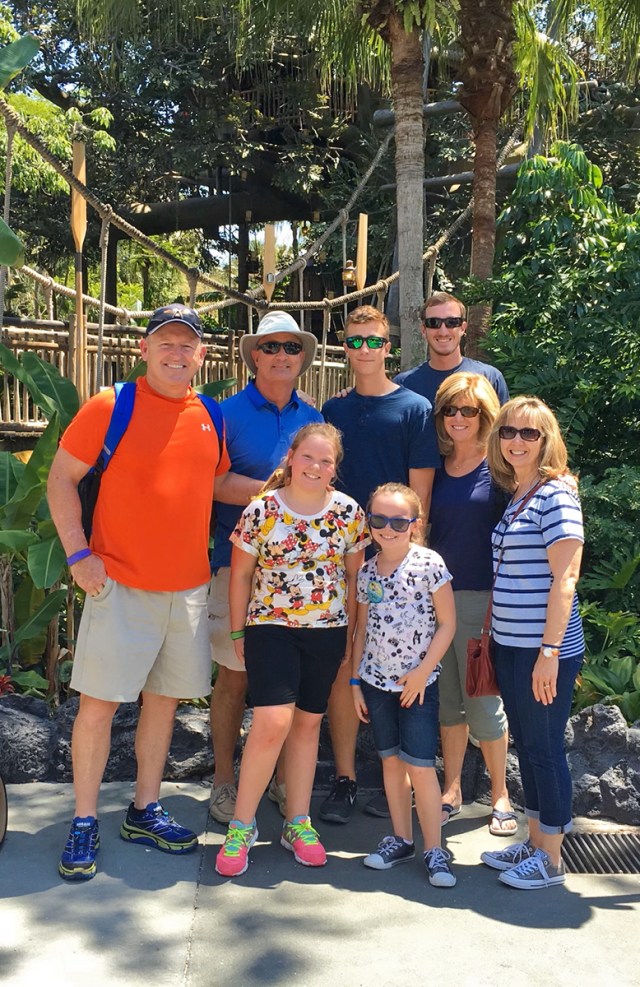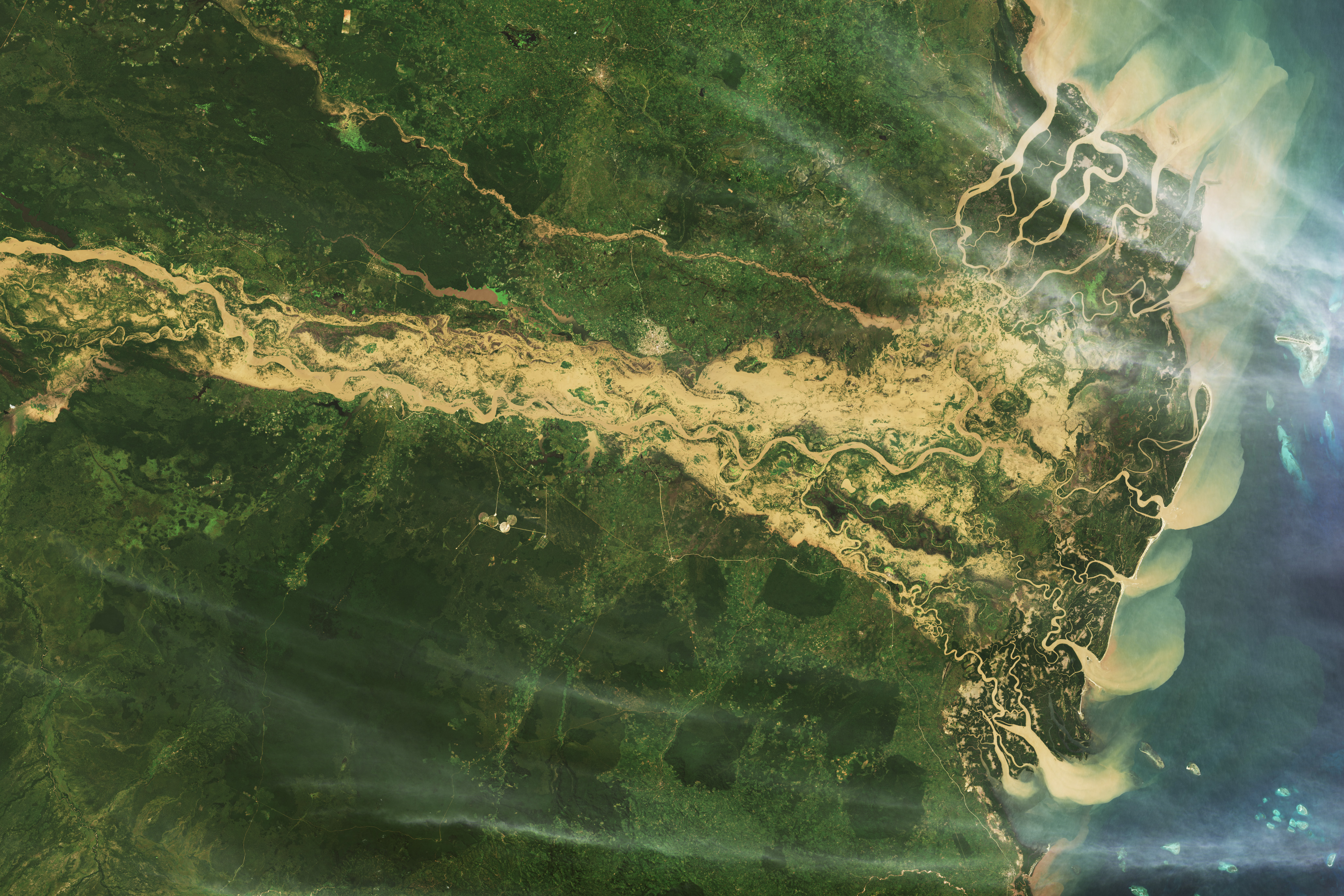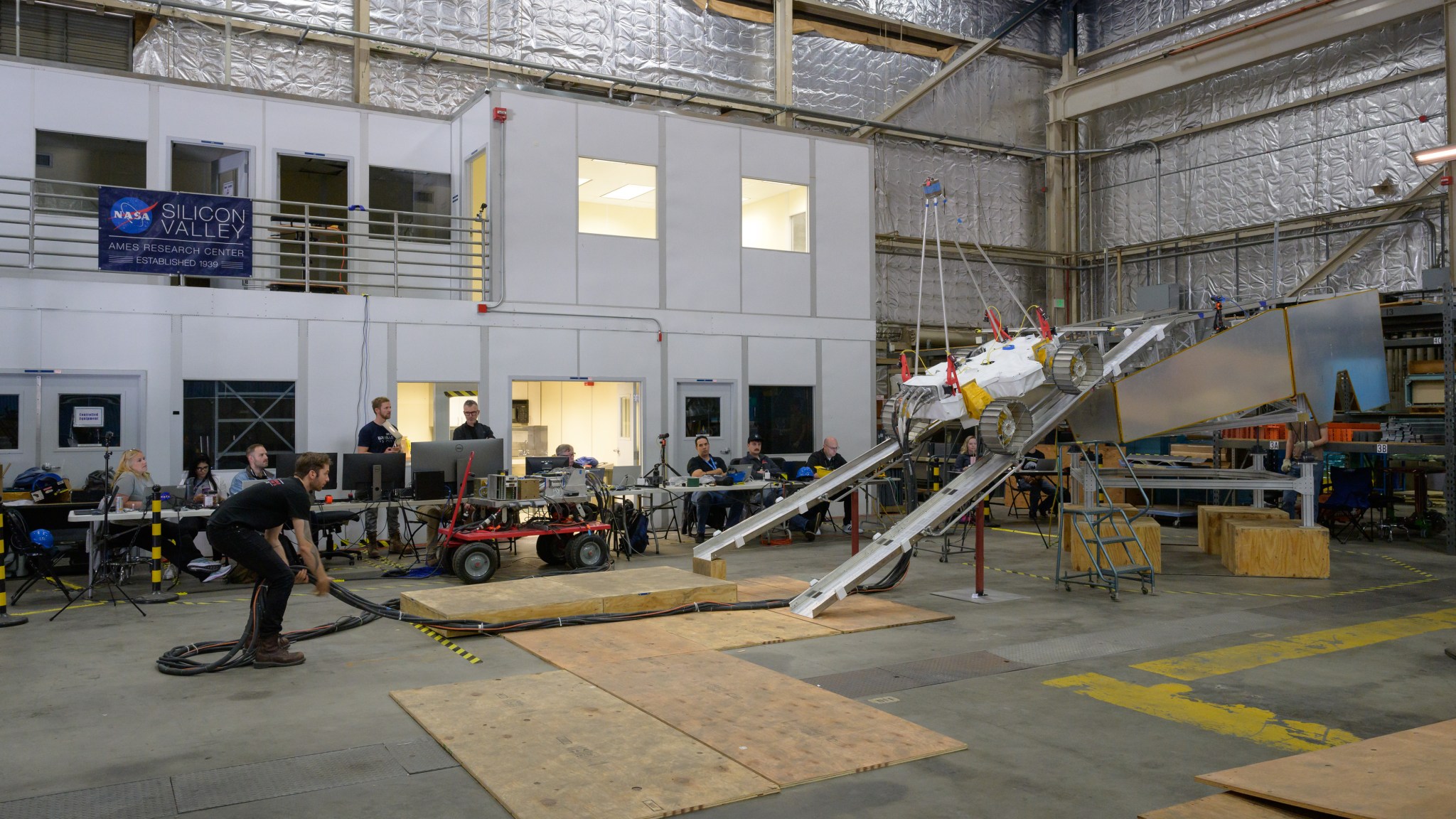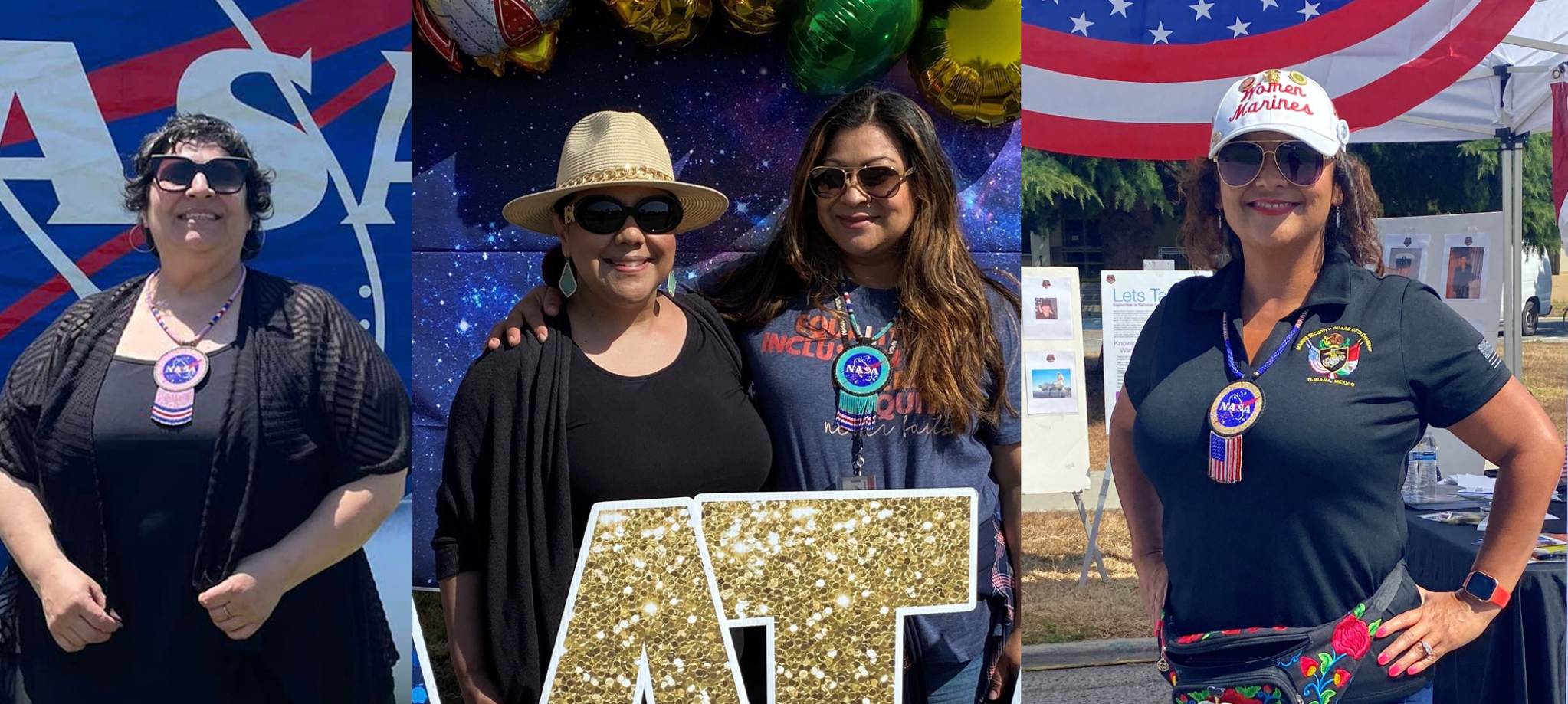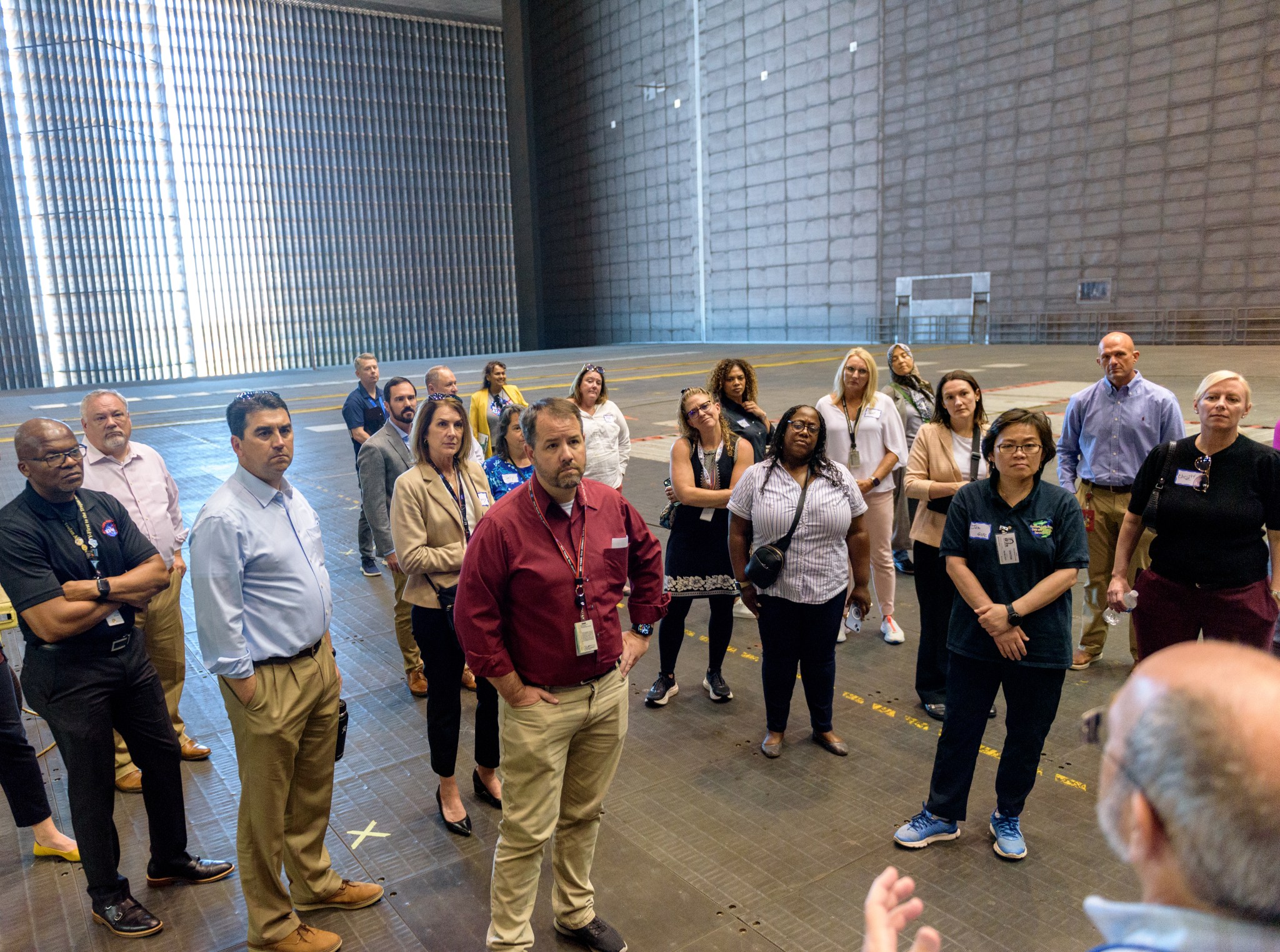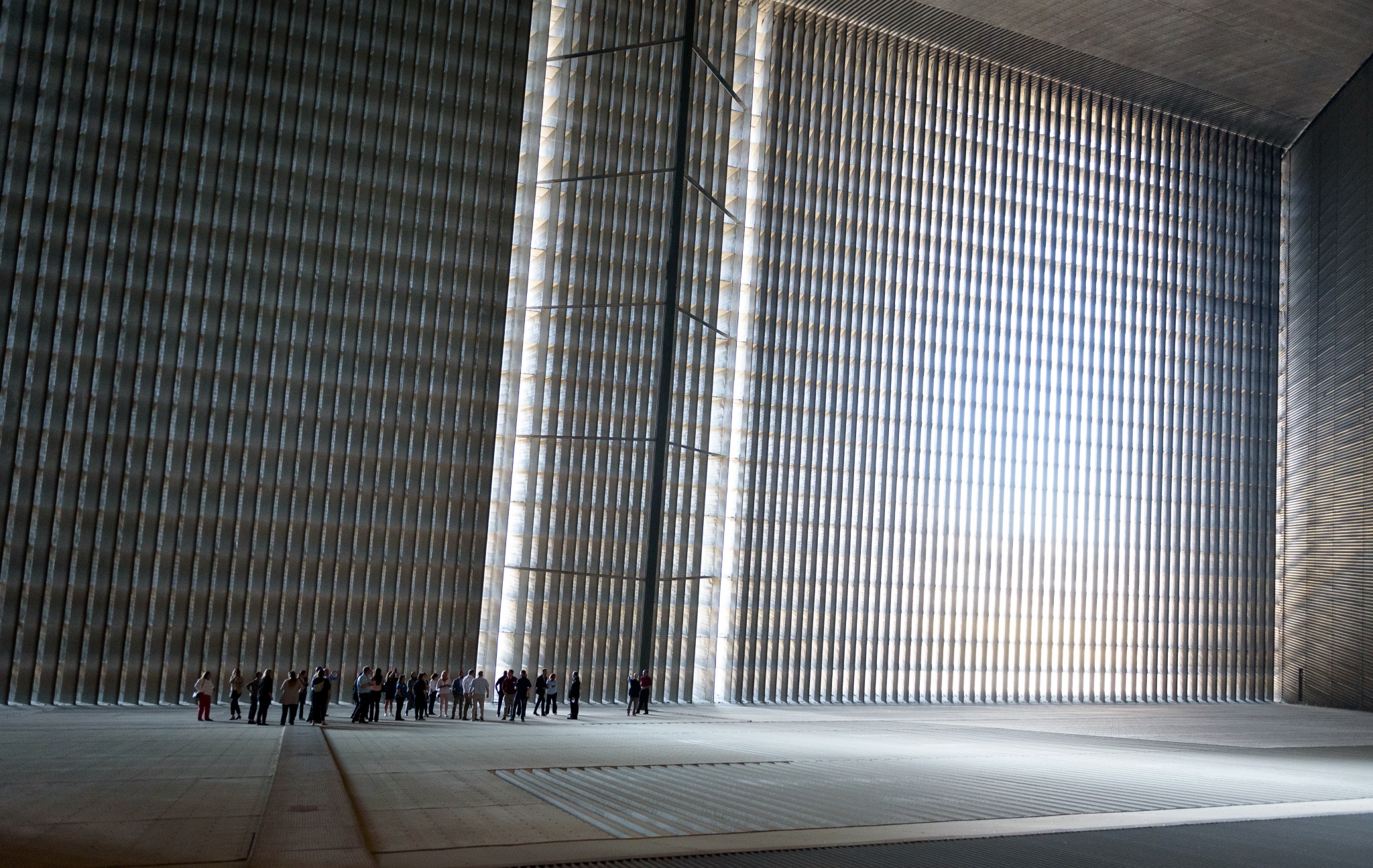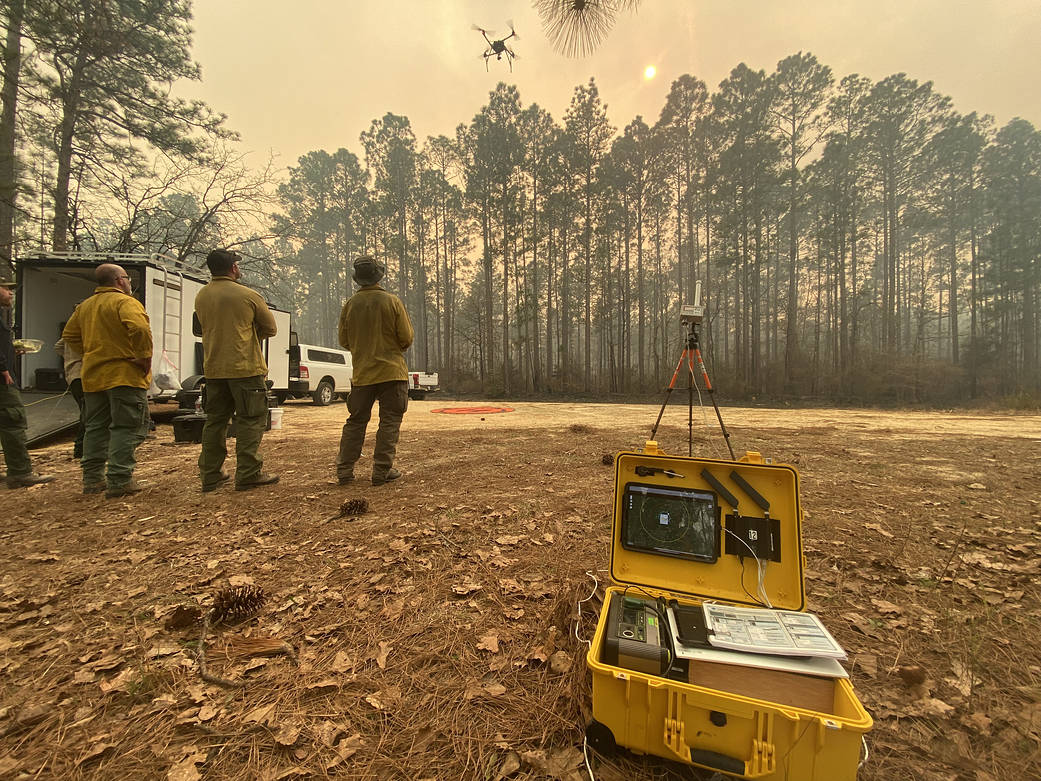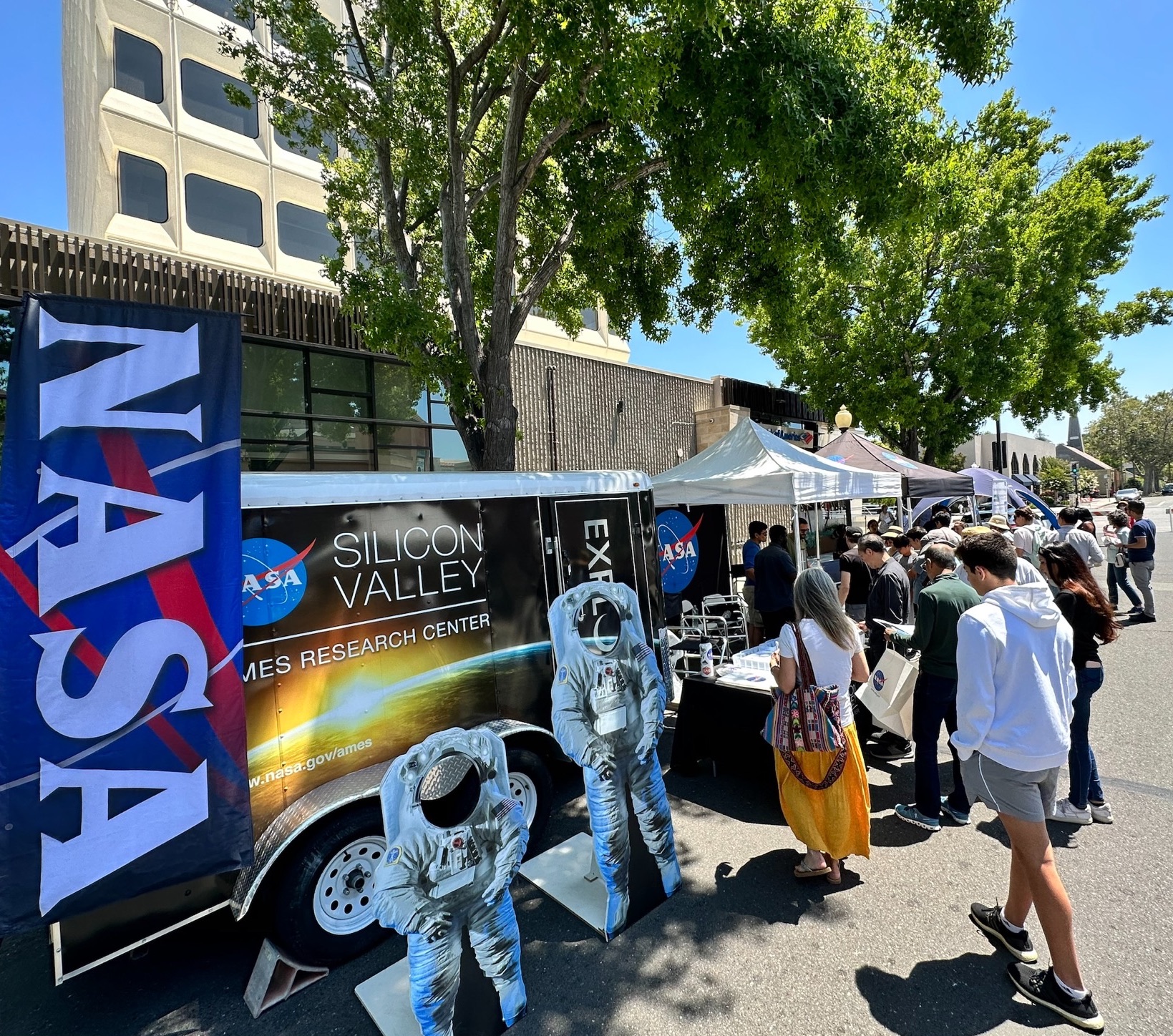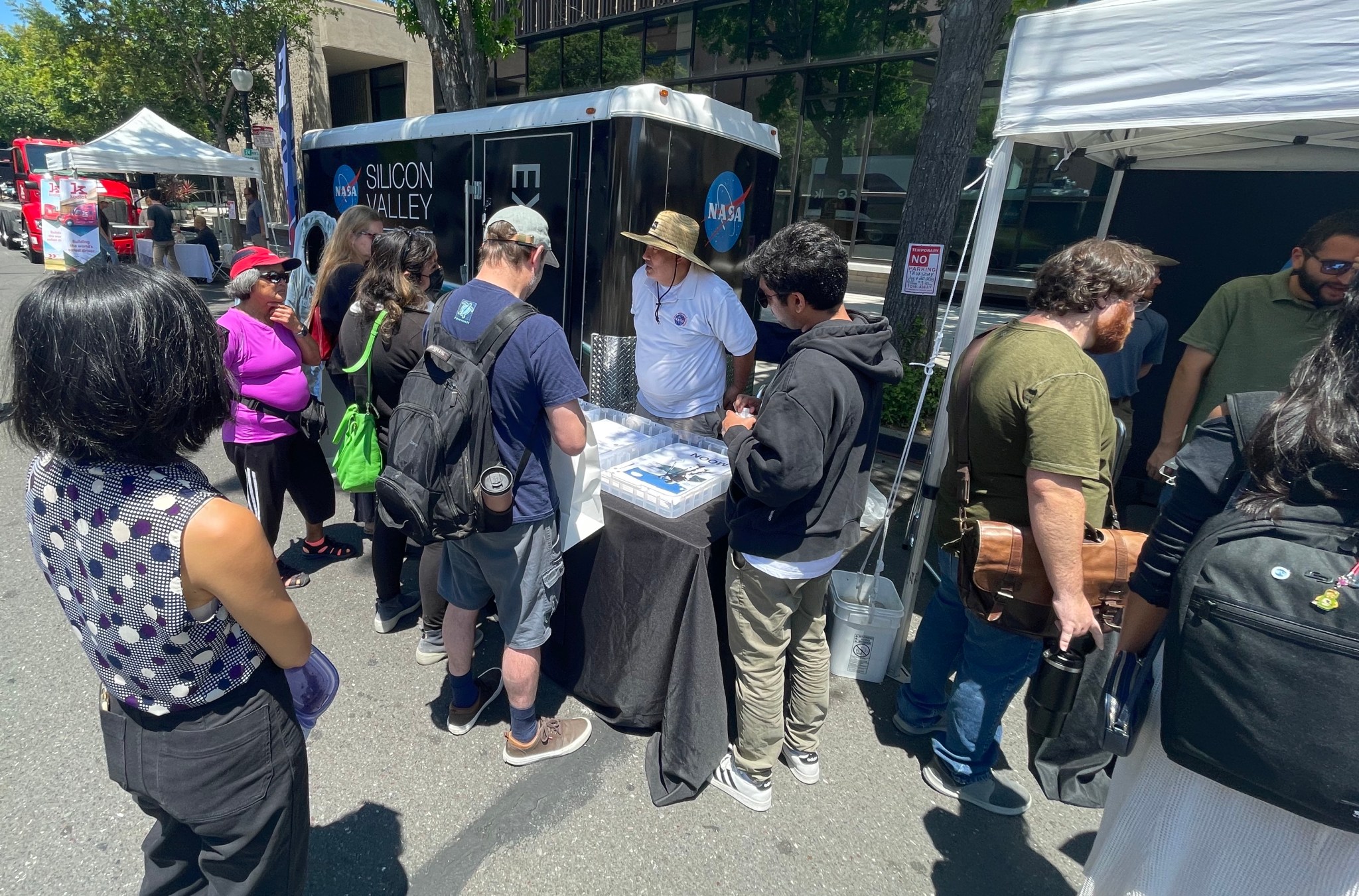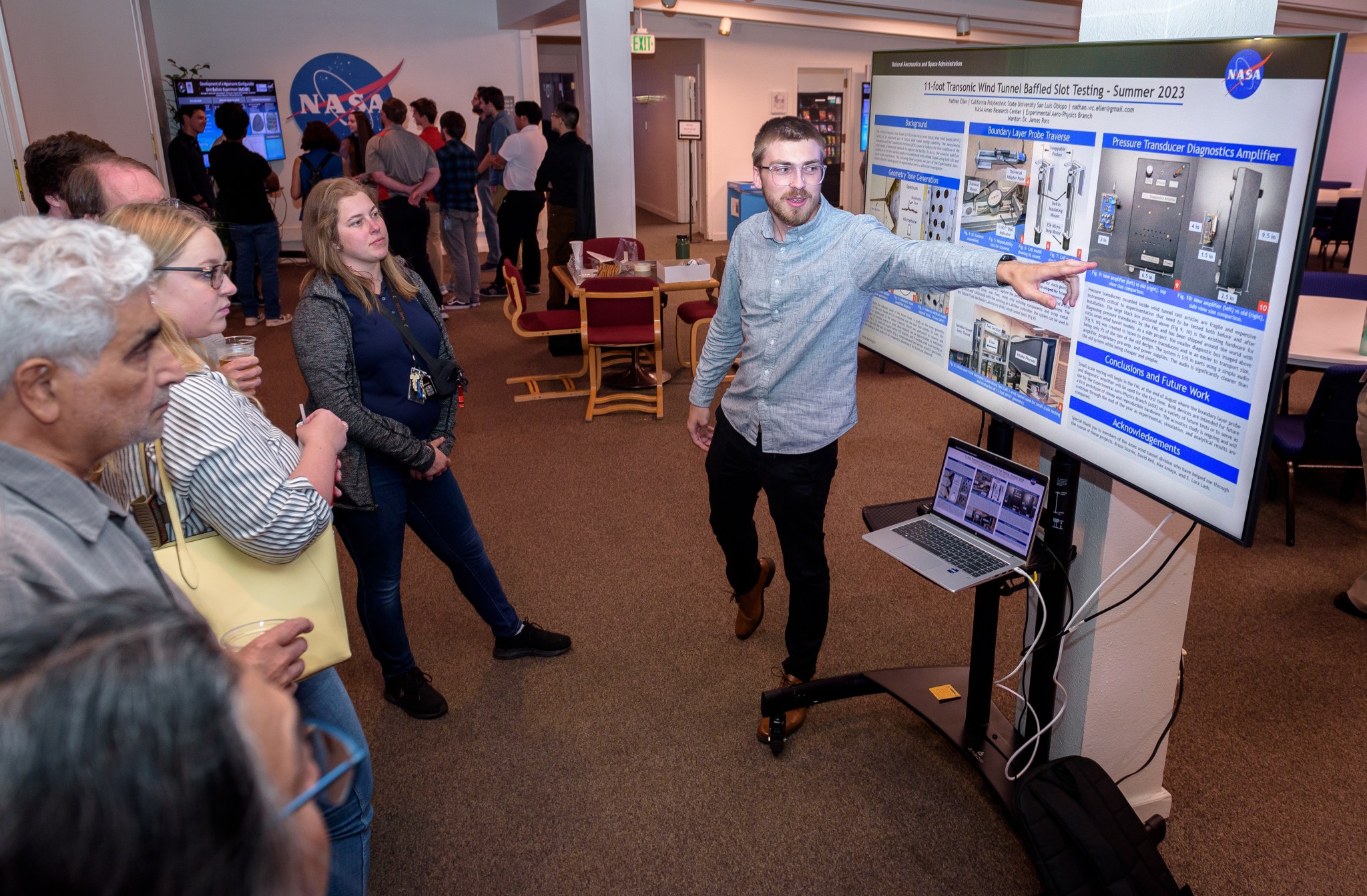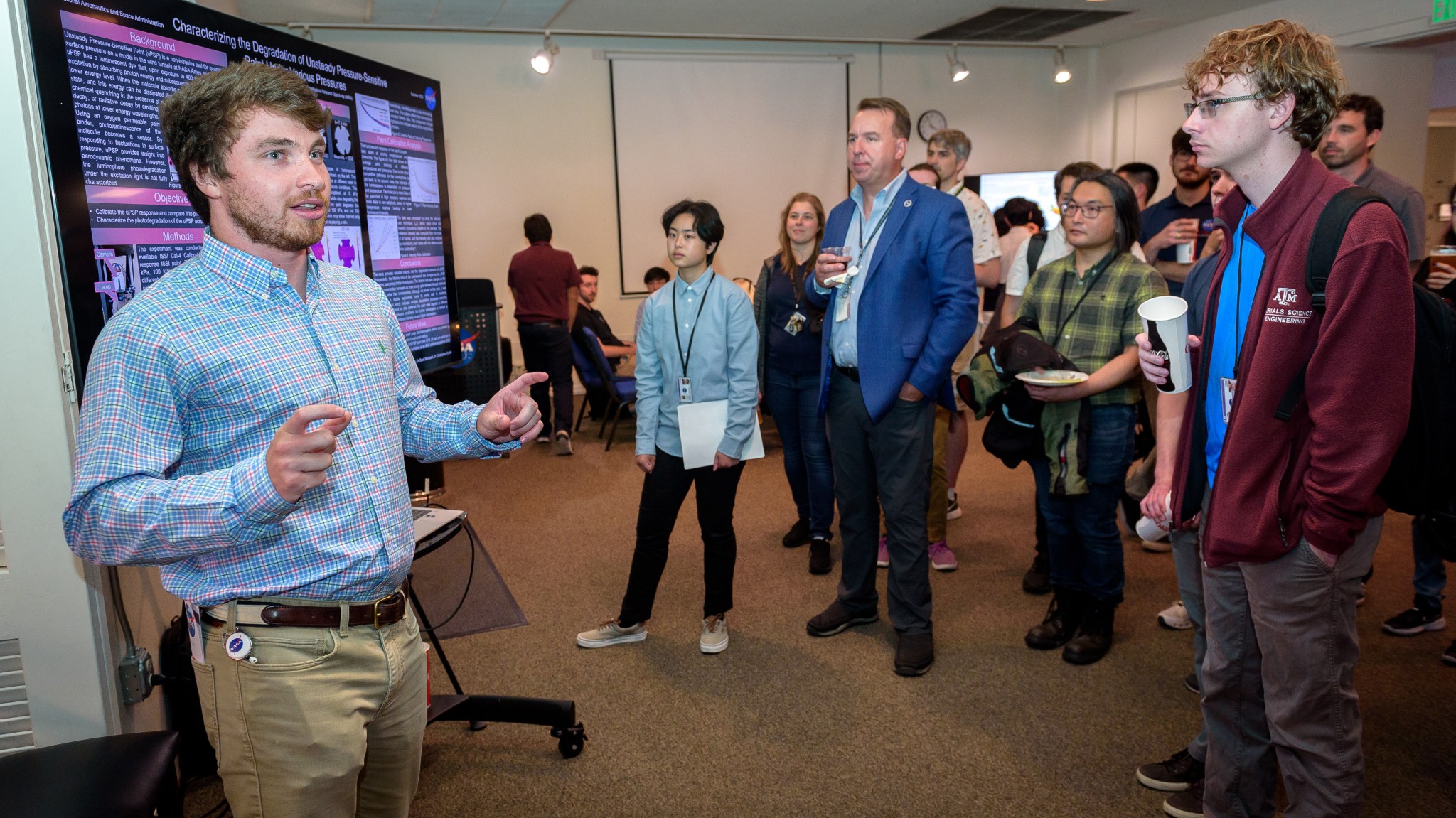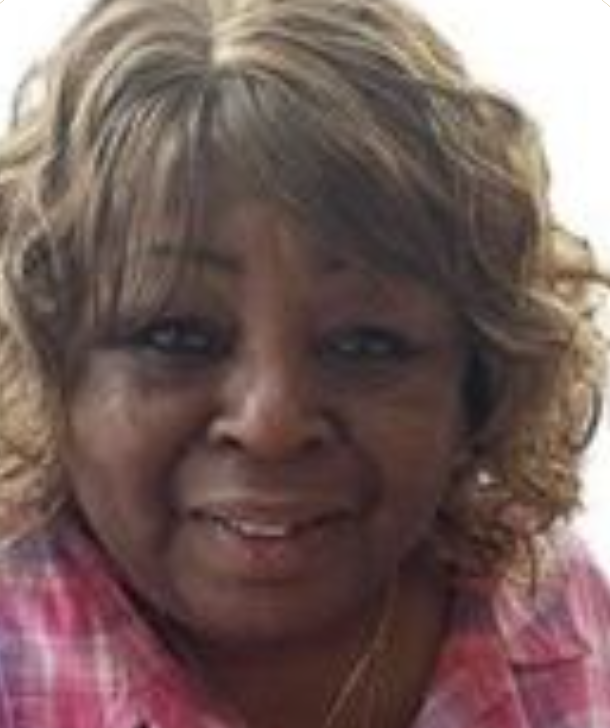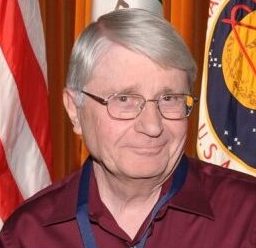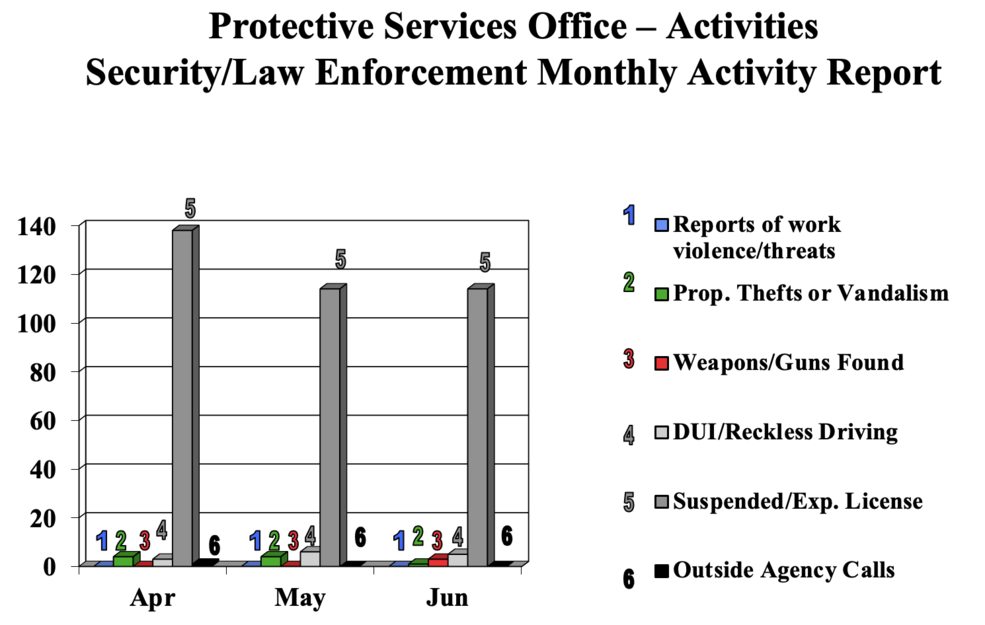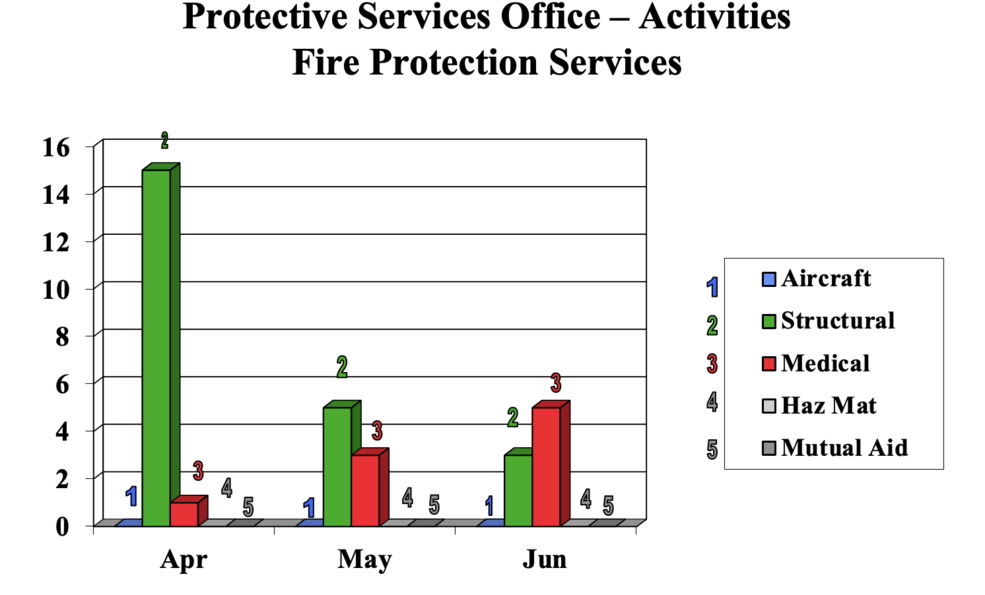NASA's Moon Rover Prototype, VIPER, Conquers Steep, Scary Lander Exit Test
by Gianine Figliozzi
NASA’s VIPER – short for Volatiles Investigating Polar Exploration Rover – recently completed another successful round of rigorous tests of the agency’s first robotic Moon rover’s ability to drive off the Astrobotic Griffin lunar lander and onto the lunar surface. Called an egress, this hours-long operation is one of the most critical and trickiest parts of VIPER’s 100-day mission. It could be even trickier if VIPER’s off-ramps onto the Moon are super steep or tilted due to uneven terrain.
Recent tests using VIPER rover and Griffin lander prototypes conducted at NASA’s Ames Research Center in California’s Silicon Valley were designed to push VIPER’s systems to the limit to ensure the rover will perform as expected during its science mission. By driving VIPER’s prototype MGRU3 – which stands for the Moon Gravitation Representative Unit 3 – down the lander’s ramps in a series of test configurations in a facility at Ames, engineers came away with a better understanding of how the rover would perform in both normal and unusual scenarios.
Unlike big rigs that deliver cars by rolling them off standardized ramps on trailers, the geometry of the lunar lander’s ramps is designed to vary substantially, depending on what the surface is like when it arrives at its target destination atop the flat-topped lunar mountain Mons Mouton near the Moon’s South Pole. Depending on the terrain around the lander, the angle of the ramps may be especially steep, posing the risk the rover could lose traction and slip – or one ramp may be steeper than the other, requiring the VIPER real-time operations team to actively compensate for this tricky terrain.
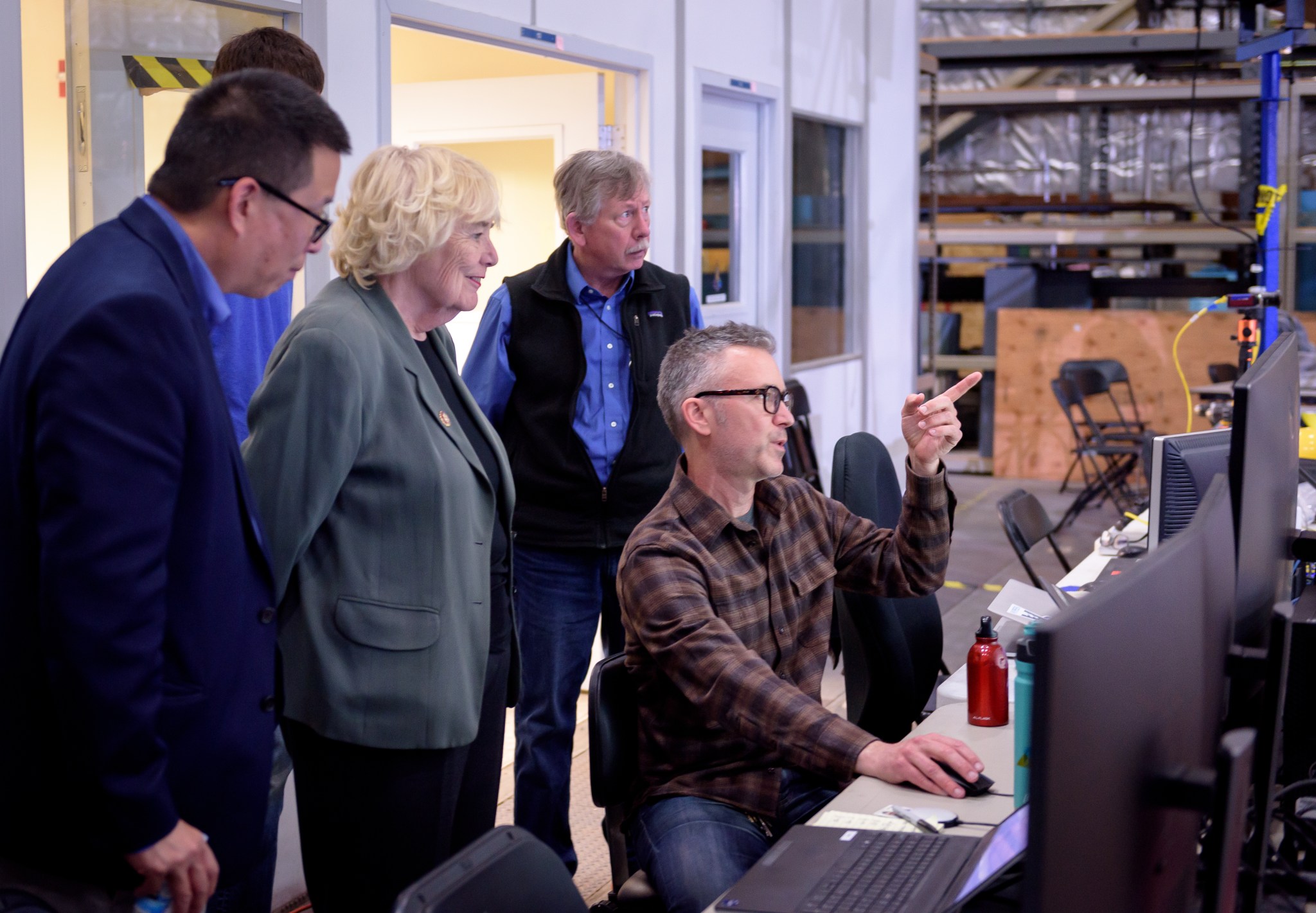
“Through this series, we’ve tested all of the ‘bounding’ cases for VIPER’s egress on the Moon,” said Jasper Wolfe, VIPER egress test lead at Ames. “This included the worst-case high-pitch scenario using the steepest – and scariest – ramps, the worst-case roll scenario using the most uneven ramps, and the worst-case scenario with pitch and roll combined.”
Seen in the photo above is a key moment of the tests, which focused on the physical interface between the rover and the lander. Critical features of the tests included software that specifically handles VIPER’s egress and changes to physical components of both the rover and the lander’s ramps. The team carefully checked to verify MGRU3 had adequate clearance and engaged the ramps correctly as it rolled from top to bottom.
“We validated these test cases with MGRU3 to be sure VIPER can do it on the Moon,” said Wolfe.
Completing these tests means that VIPER should be able to successfully exit the lander even if it touches down in a tough spot – a major step forward toward flight.
“With VIPER, we’re doing a lot of firsts,” said Wolfe. “And it’s very exciting to reach this milestone.”
Employees Enjoy Food, Tech Demos, and Learn About the Ames Employee Resource Groups at the 2023 Summer Picnic
This year’s Ames summer picnic drew quite the crowd, upwards of 1,500 employees. Attendees heard center management speeches, enjoyed the hotdogs provided by the Ames Exchange, learned more about the employee resource groups, learned safety tips at the health and safety booths, and listened to research and science staff members share their technical innovations such as the VIPER mission and the Mars Helicopter. In addition, there were also performing robots and Chabot meteorites to view. Below are just some of the photos taken at the picnic.
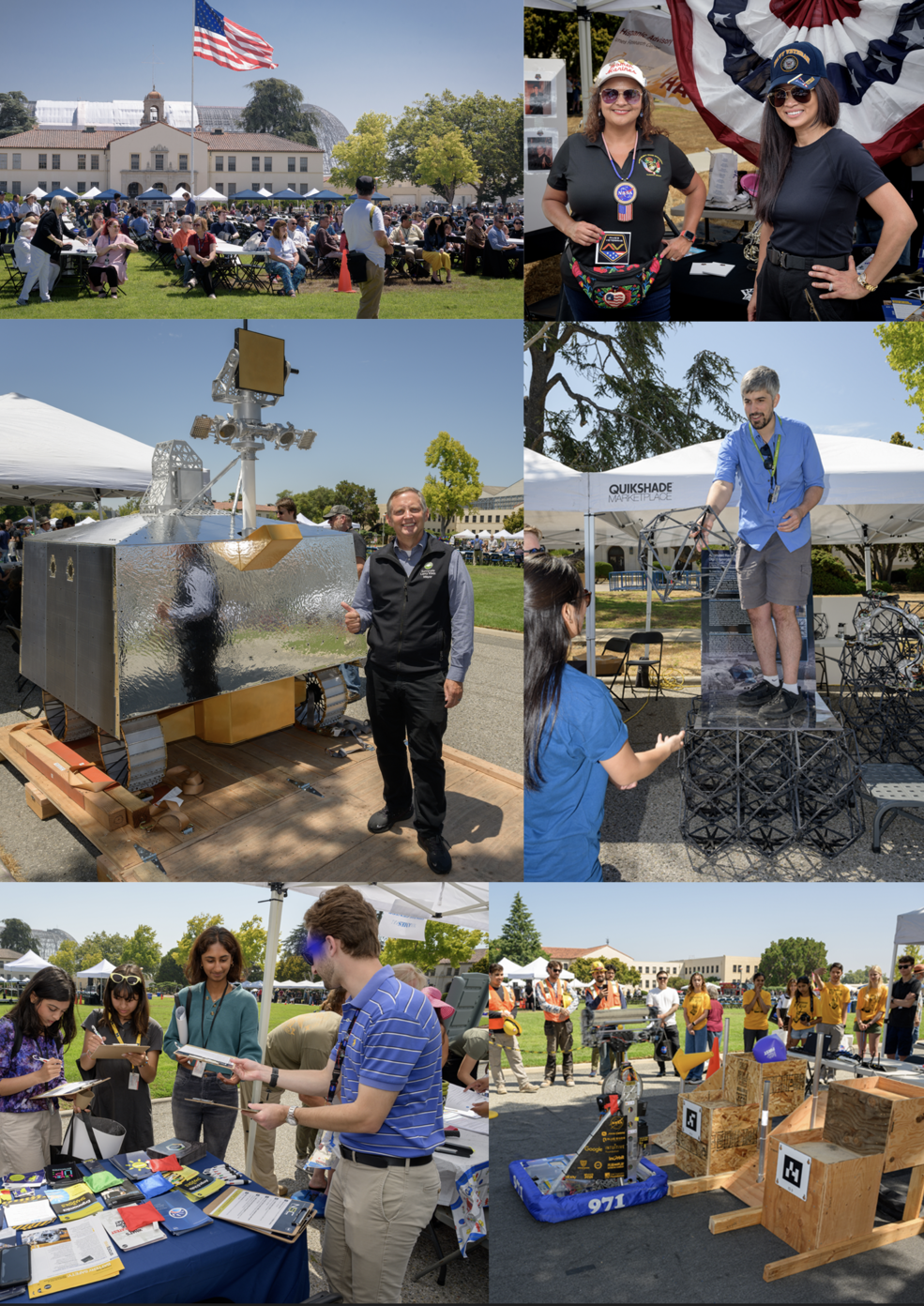
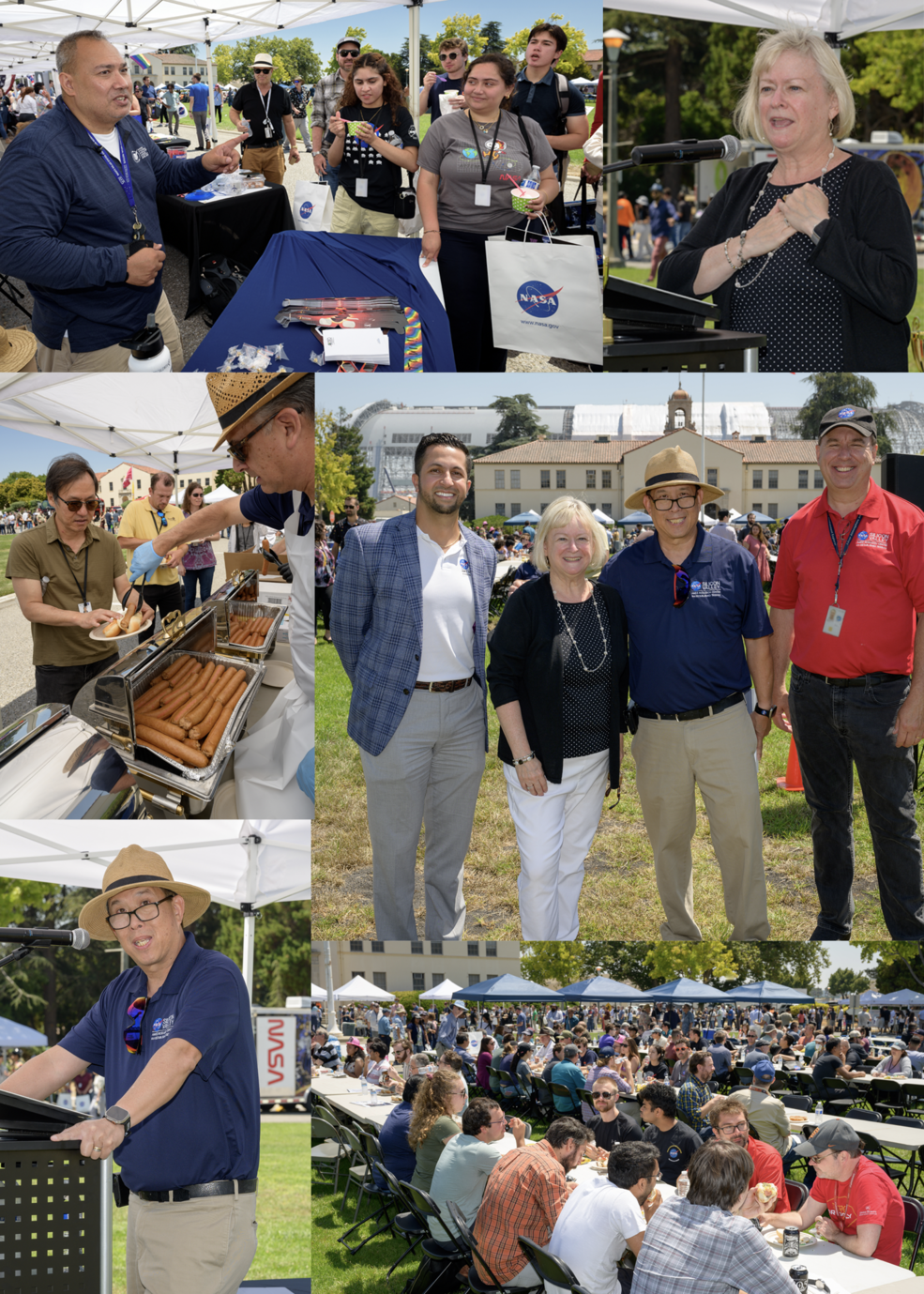
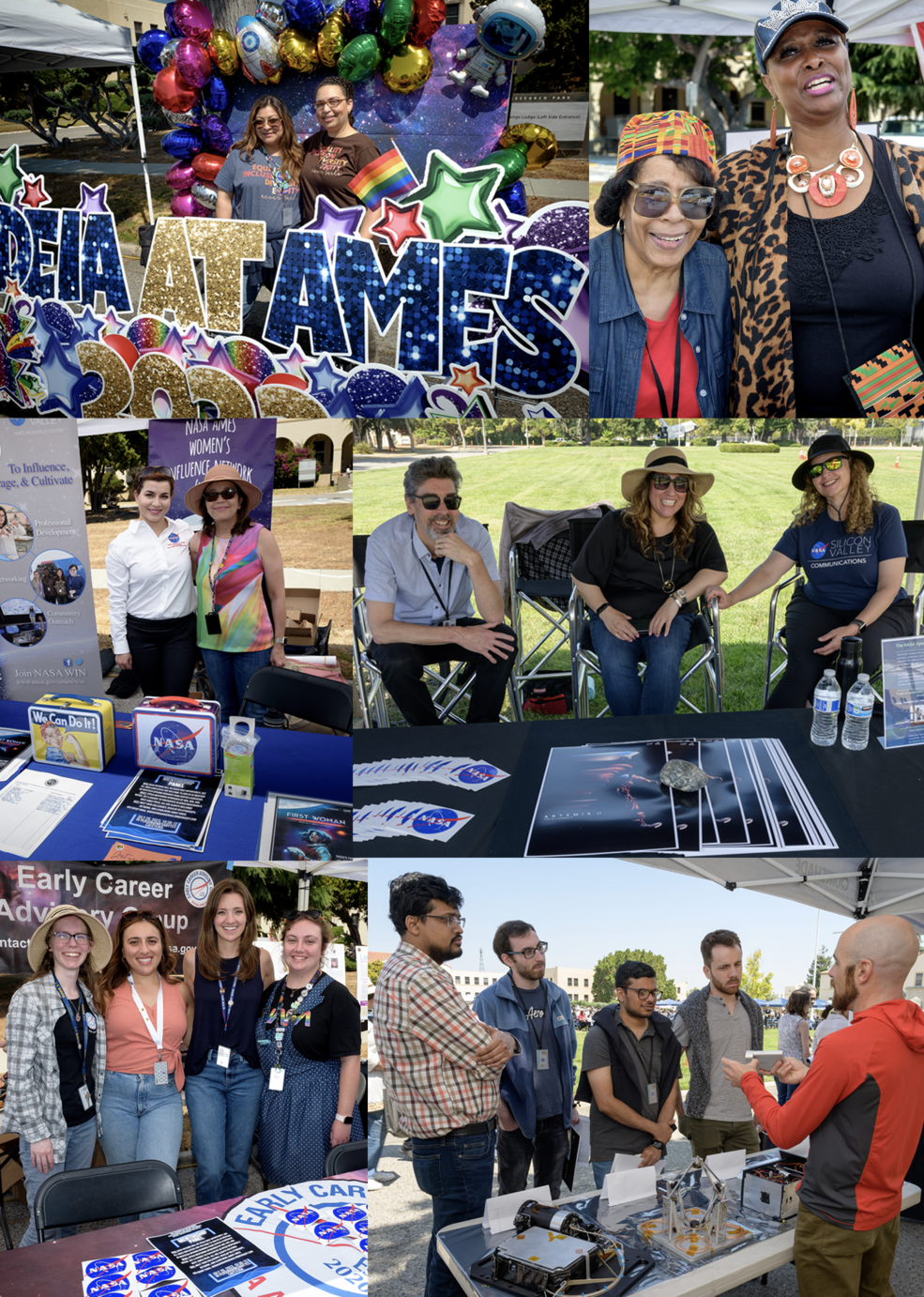
Ames Receives Honorable Mention, 2023 NASA Software of the Year Award
Ames has received an “Honorable Mention” for the 2023 NASA Software of the Year (SOY) award for ‘Unsteady Pressure-Sensitive Paint (uPSP) Data Processing Software – Additions and Improvements,’ which was among six submissions competing this year. The agencywide annual SOY competition rewards high-quality, innovative, and robust software using efficient software engineering processes that meet NASA’s stringent safety and reliability standards. Sponsors of the competition include the NASA Chief Engineer, the NASA Chief Information Officer, and the NASA Office of Safety and Mission Assurance. NASA’s Inventions and Contribution Board (ICB) reviewed and ranked the nominations, in coordination with the sponsors.
uPSP Software Description
The uPSP software is a collection of applications developed to process raw data from unsteady pressure-sensitive paint (uPSP) data acquisition systems. The applications implement a set of processing steps that receive high-speed camera video files, wind tunnel flow condition data, and pressure-sensitive paint calibration data, and produce spatially-dense time histories of surface pressure on a three-dimensional model of the wind tunnel test subject.
Developed during a series of NASA’s Space Launch System (SLS) buffet and aeroacoustic wind tunnel tests at NASA Ames’ Unitary Plan Wind Tunnel, the uPSP technology is capable of acquiring fluctuating pressures up to 20 kHz with continuous spatial resolution which enables direct calculation of unsteady loads. During test campaigns, a direct connection was established between the Unitary Plan Wind Tunnel and the NASA Advanced Supercomputer, both located at Ames. The rapid transfer, processing, and display of high-speed PSP data from the wind tunnel demonstrated the ability power of experiment-in-the-loop testing enabling informed, real-time decisions, decrease design cycle time, and securely share the data with subject matter experts while the test campaign is active.
Every new software developed or improved, helps advance agency work and makes a difference. Employees are encourage to submit disclosures on their software and technology development work to make these important benefits a reality.Much appreciation and special thanks goes to the Ames’ Technology Transfer Office, Inventions and Contributions Board (ICB) members, and 2023 NASA SOY selection panel members who reviewed and selected the technology that Ames put forward for the agencywide competition. They helped assemble, vet, and submit the nomination package and helped prepare the team for their final presentation delivered to the SOY judging panel.
Congratulations to the uPSP team for this recognition by the agency and for continuing the Ames tradition of leading the agency in software development!
Awardees of the FY23 Internal Research and Development (IRAD)
The IRAD develops strategic technical capabilities in support of the center competencies and thereby enables science, technology, and engineering efforts for future agency missions. The advances in science and technology expected through this program will provide opportunities for technical risk reduction and/or increased cost effectiveness and initiate potentially transformational solutions.
Please join in congratulating the FY23 IRAD awardees:
Don Banfield, Mars Doppler Wind & Thermal Sounder (DWTS): Ozone Gas Cell Development
Anthony Colaprete, Atmospheric Structure Investigation (ASI) for New Frontiers OPIS (Observatory for probing internal Saturn Atmosphere) Proposal
Jay Feldman, Modernization of Tile Manufacturing for Reusable Thermal Protection Systems
Kevin Fogarty, Prototype for the PIAA-Vortex Coronagraph
Jeremy Frank, Adaptive Automated Airborne Mapping of Dynamic Flows
Matthew Gasch, Affordable Robust Compliant TPS (ARCTPS)
Marcus Murbach, Nano-sat Re-entry Demonstration of a Self-stabilizing Probe: In-situ Measurement of the Edney Type 4 Shock-Shock Interaction
Raj Pai, AviateNLP, Foundation Artificial Intelligence Model for Aviation
Richard Quinn, MICA: Microfluidic Icy-World Chemical Analyzer Technology Advancement and Risk Reduction
Antonio Ricco, Maturing and Testing SPLIce: Demonstration of Mission-Critical Functional Performance Required for a Successful New Frontiers 5 Proposal
Yasaman Shirazi, Quantitative microRNA sequencing on a nanopore platform
Mary Beth Wilhelm, Grinding Rocks in Martian Gravity: Preparing for Partial-g Flight Testing of the ExCALiBR Comminutor Subsystem with ARC UAS
This year, the IRAD was highly competitive with more than 30 proposals submitted from across the center. Everyone’s interest in this important program is very much appreciated and we all look forward to hearing about the results of these investigations.
Congratulations to all of the FY23 IRAD recipients!
Visit the IRAD Website for more information: www.nasa.gov/ames/irad
NASA's ASPIRE Participants Tour 80-foot-by-120-foot Wind Tunnel
NASA Study Reveals Compounding Climate Risks at Two Degrees of Warming
by Abigail Tabor
If global temperatures keep rising and reach 2 degrees Celsius (3.6 degrees Fahrenheit) above pre-industrial levels, people worldwide could face multiple impacts of climate change simultaneously. This is according to a NASA-led study that analyzed the projected impacts of such warming to understand how different climate effects might combine. A 2-degree rise in global temperatures is considered a critical threshold above which dangerous and cascading effects of human-generated climate change will occur.
The researchers found that more than a quarter of the world’s population could experience an additional month of severe heat stress each year compared to the middle of the 20th century (1950-1979). High temperatures and drought could combine dangerously in places like the Amazon, increasing the risk of wildfire. In the American West, extreme fire weather will likely be more intense and last longer.
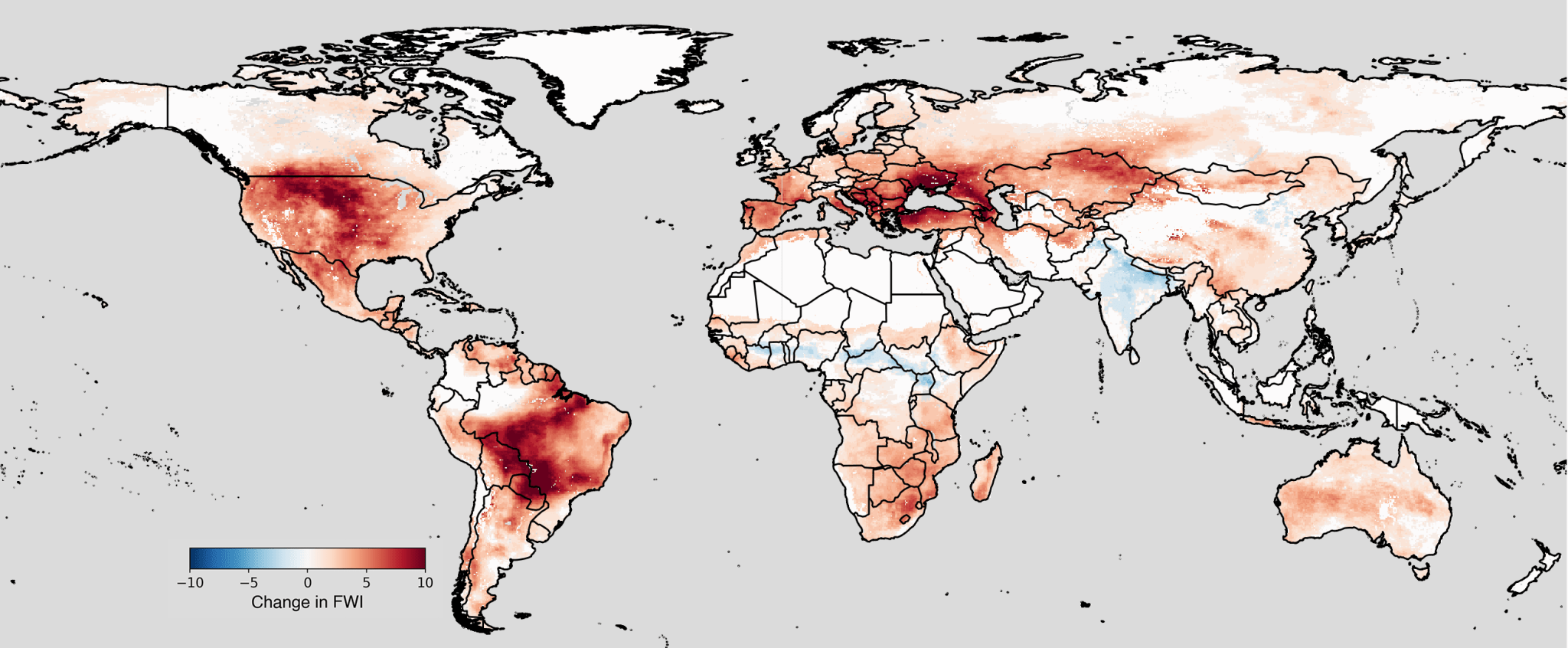
To investigate potentially compounding effects of rising temperatures, the study’s authors worked with a specially processed set of climate predictions. The predictions were originally generated by 35 of the world’s leading climate models – specifically, contributors to the Coupled Model Intercomparison Project (CMIP), which includes models developed by the NASA Goddard Institute for Space Studies. CMIP provides climate projections that help the Intergovernmental Panel on Climate Change and other international and national climate groups understand historical, current, and future climate changes.
Researchers at the NASA Earth Exchange (NEX) then took the output from CMIP6 models and used advanced statistical techniques to “downscale” them, improving the resolution significantly. NEX uses supercomputers at NASA’s Ames Research Center in California’s Silicon Valley to analyze vast amounts of data collected by aircraft and satellites or, in this case, projections produced by climate models. The resulting NEX dataset supporting this research is available to the public and can be found online.
Combining Climate Impacts
With the new dataset in hand, NEX researchers at Ames analyzed the downscaled projections to assess the changes predicted for six key climate variables. They examined changes in air temperature, precipitation, relative humidity, short- and longwave solar radiation, and wind speed at a point when warming passes 2°C.
“We wanted to study how these aspects of the environment are projected to change and what their combined impacts could mean for people around the world,” said Taejin Park, first author on the paper and a researcher at Ames with the Bay Area Environmental Research Institute (BAERI).
The researchers paid special attention to two climate indicators: heat stress – or the combined effects of temperature and humidity on the human body – and fire weather – which considers temperature, rainfall, humidity, and wind. Most regions of the world will experience higher heat stress, they found, while countries closer to the equator will suffer from a greater number of days considered extreme.
“The escalating impacts of all the climate extremes studied could cause significant damage to communities and economies, from fires, floods, landslides, and crop failures that may result,” said Ramakrishna Nemani, senior scientist at BAERI and co-author of the study.
Democratizing Climate Data
The NEX downscaled dataset used for this research provides global, daily climate projections, derived from CMIP6 climate models, out to the year 2100. The day-to-day nature of the NEX product is important for capturing the extremes. If merged into a monthly average, Park explained, a few days projected to be dangerously hot and humid could get lost in the numbers, concealing the risk for human lives.
The level of local and regional detail – the resolution of the projections – is higher in the NEX product than most climate projections, which could help leaders develop targeted climate adaptation and mitigation plans. Raw climate model projections typically give results for areas of about 120 by 120 miles (200 by 200 kilometers), while the NEX downscaling work increases that resolution to about 15 by 15 miles (25 by 25 kilometers).
Downscaling this much data is a big job, and NEX researchers relied on NASA’s powerful Pleiades supercomputer at Ames. Pleiades helps solve some of NASA’s most challenging problems, playing an important role in rocket launches for the Artemis program, fuel-efficient aircraft designs, and studies of Earth’s climate.
NEX scientists hope that the downscaled climate projections could help decision-makers prepare for and protect their regions against climate impacts. For example,a local policymaker could decide to build more flood barriers or pursue less development in flood-prone areas, said Ian Brosnan, co-author of the paper and principal scientist at NEX.The NEX dataset can also help new commercial and non-profit enterprises develop customized climate-risk assessments for the private and public sectors.
“The downscaled NASA data is in really accessible form,” Brosnan said. “People everywhere with some technical ability – from undergraduate students to experienced climate scientists – can dig into the information these projections contain.”
Unitary Plan Wind Tunnel Outdoor Display Gets Facelift
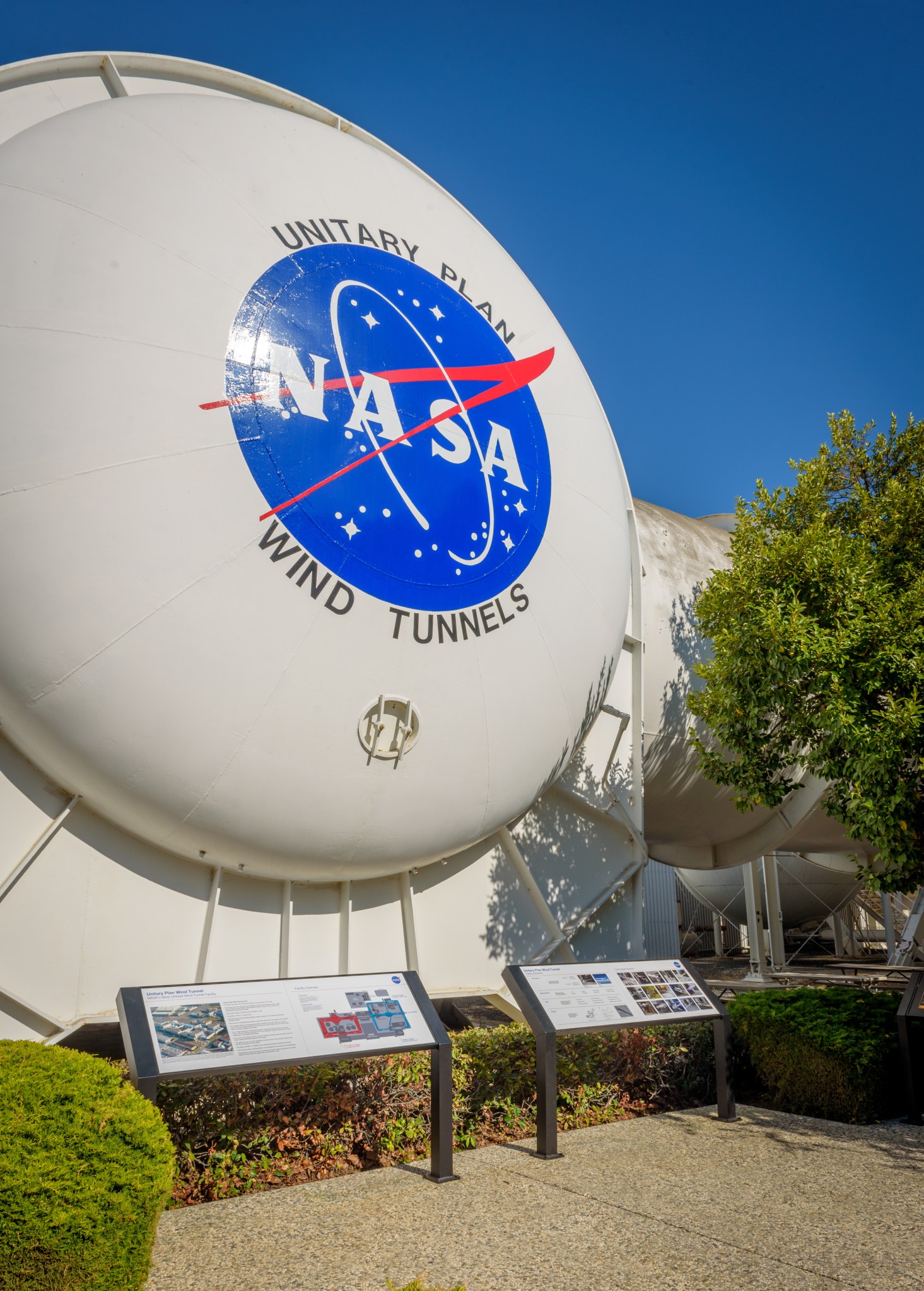
NASA Tests Mobile Air Traffic Kit During Wildfire Prevention Operations
by Hillary Smith
NASA researchers recently tested a mobile air traffic management kit for remote ground pilots across forests throughout Tennessee, Mississippi, Georgia, Florida, and South Carolina. During the testing, U.S. Forest Service pilots remotely operated Unmanned Aircraft Systems (UAS), or drones, to drop ping pong ball-sized plastic spheres that ignited on impact, precisely burning dead brush that acts as fuel to wildfires. The testing was in support of NASA’s Wildland Fire Management Initiative.
The Aerial Ignition Academy training, hosted by the U.S. Forest Service, in collaboration with the National Interagency Prescribed Fire Training Center, provided pilots with a chance to train using drones for prescribed burns, a wildfire prevention and land management technique that employs the controlled use of fire to burn fuels like dead brush and vegetation. During the training, researchers from NASA’s Advanced Capabilities for Emergency Response Operations (ACERO) project shadowed drone pilots as they trained in the field and collected data on the use of NASA’s mobile air traffic pilot kit. The kit alerted pilots positioned in forests throughout the five southwestern states to air traffic detected in the surrounding area. This enhanced their ability to avoid conflicts while conducting these prescribed burns.
Drone pilots are accustomed to monitoring their airspace by visually scanning for neighboring aircraft, listening for their engine sounds, and tracking local air traffic radio channels. The kit complements that awareness by providing a cohesive view of crewed aircraft and their location in the airspace.
Prescribed fires are currently set by a mix of firefighters on the ground using tools known as drip torches, and pilots in helicopters dropping ignition spheres over large areas of land. Igniting the burns with drones can remove firefighters from harm’s way by offering a safer approach to prescribed burns. Under NASA’s Scalable Traffic Management for Emergency Response Operations (STEReO) project, the U.S. Forest Service became a key collaborator during the initial stages of this technology, and continues to support the development of new versions that could enable the safe integration of drones into mainstream use for wildfire prevention and land management.
The recent field testing gave ACERO team members insight into how the kit performs in a prescribed fire environment. The ACERO team also gathered feedback from drone operators regarding the kit’s design features, user interface, and general capabilities.
“It was a successful data collection exercise,” said Lynne Martin, lead of ACERO’s Wildfire Airspace Management team at NASA’s Ames Research Center in California’s Silicon Valley. “We demonstrated the kit to 24 trainees and eight instructors and obtained feedback from all.”
Team members are currently analyzing data and feedback from the emergency response crews, which will inform ACERO’s technology development in the coming years. The ACERO project will perform additional field testing on the kit later this year and prepare the kit for mainstream adoption by wildfire agencies across the country, such as the U.S. Forest Service, California Department of Forestry and Fire Protection, and others. The work done under STEReO is already being leveraged by early adopters within the U.S. Forest Service, and ACERO will build on that momentum to unlock greater use of airspace at high levels of safety.
The ACERO project is focused on advancing airspace management technologies to improve wildfire management operations and enable remotely piloted drones to safely monitor and operate on wildland fires 24 hours a day, seven days a week. In the coming years, ACERO will partner with industry and wildfire response agencies to perform joint field demonstrations of these newly developed aviation technologies.
Ames Tech Transfer Office Shares Innovations, Business Opportunities During Tech Showcase
Mountain View’s Tech Showcase Day, held this year on July 20, is a live event that is free to attend, and open to all. It takes place in the Civic Center Plaza, downtown Mountain View. It’s a rare opportunity to experience first-hand the diversity among the technology community and the newest ideas created in our own backyard.
The Ames booth area this year included a display from the Airspace Operations Lab’s drone projects and TechEdSat teams. The Office of Communication, OComm, brought the public engagement trailer and provided a photo opportunity with the Artemis astronaut cutouts. OComm also handed out posters and NASA “meatball” stickers. There was a steady flow of visitors to the Ames booth. Members of the public, including young families, businesswomen/men took time out of their workday from 11 a.m. to 3 p.m. to visit the booth.
Partnerships also participated with Jay Singh and Kimberly Minafra of the Ames Technology Transfer (T2) Office providing information/handouts to visitors, highlighting the many innovations and contributions NASA has made since the Apollo Program that have influenced everyday life. They shared information about NASA’s patent portfolio and software catalog to companies and students. In fact, a few companies interested in how to work with NASA have already reached out via email for additional information on how to collaborate/use Ames’ facilities to test their technologies and how to license NASA patents. The Ames T2 team showed examples of commonly known everyday products that have been developed based on NASA technologies and helped visitors navigate the spinoff.nasa.gov and homeandcity.nasa.gov websites.
The event was a great opportunity to show the local community how much NASA is in their everyday life and that NASA Ames is open for business!
Interns Hold Summer Poster Session
The Office of STEM Engagement was proud to revitalize the Ames Poster Session this summer on Aug. 9 during the Ames Happy Hour in the SpaceBar. Interns from any project, organization, or academic level were welcomed to present their work to the Ames community. Posters, research overviews, or other video content were displayed on monitors on a rotating basis.
In Memoriam …
Dephina Turner Passes Away . . .
Delphina Turner dedicated more than 35 years of service to NASA Ames. She was a vital part of the Ames finance community and supported many areas during her time here. Delphina developed lasting relationships with her colleagues and touched the hearts of many. It was a true honor to have her as part of our Ames community and she will be greatly missed. She was a wonderful person, beloved mother, awesome grandmother, hip great-grandmother, and amazing colleague, and member of our NASA family.
Born in Ventura, California, she was blessed to live all over the world. Hawaii and Japan were a couple places she called home but ultimately, she settled here in Silicon Valley. She demonstrated great work ethic, building meaningful relationships along the way. Once her children were grown and on their own, she spent her last days in San Jose, near her family.
Delphina is survived by her three children, Ranessa, B.J., and Daylon along with their wonderful families. A NASA flag was flown at Ames in her remembrance. In our memories, we will remember Delphina’s legacy of building cherished relationships, displaying a strong work ethic, and dedicated service to the center.
John Humbert Passes Away
John passed on August 17, at the age of 82, surrounded by loved ones. Many at Ames have worked with John and have been positively impacted by him during his time at NASA. John will always be remembered for his integrity, kindness, and the respect and fairness he demonstrated to all, during his 59-year career. His contributions to Ames, NASA, and the nation were memorable, significant, and profound.
Over the course of his career, John’s skill, leadership, and dedication in effectively completing challenging projects earned him three NASA-level Exceptional Achievement Medals, and numerous NASA and Ames Honor awards. A NASA flag will be flown at Ames in his remembrance.
John Humbert joined the staff of Ames Research Center in 1963 and his initial assignment was the design of electronic instrumentation for life sciences researchers. From there Humbert’s career saw amazing technological changes as he helped usher in hardware and software to interconnect minicomputers with instruments to automate Ames research laboratories. From there, he moved onto national contributions as project engineer for the Ames Central Computer Facility (CCF), where he designed custom communications interfaces to interconnect the Center’s IBM mainframe computer with the data acquisition systems in the center’s twelve primary wind tunnels.
Humbert was also responsible for the center’s mainframe computers and the digital communications for remote computer access, and he led a team to acquire a new high-speed processor resulting in the installation of the CDC 7600 computer system, which provided a tenfold increase in CCF processing capacity. John’s career included acquiring the first Ames’ supercomputer, a Cray-1s system, and later acquired the CDC Cyber 205 supercomputer system, which doubled the center’s supercomputing capacity. Humbert also developed a competitive acquisition strategy to acquire a wide range of UNIX-based mid-range systems, which served as the model for today’s agency SEWP program. He continued his profound contributions to NASA’s mission on agency planning teams to address consolidation of field center supercomputer resources–first in the Aeronautics Enterprise and later across all of NASA. Humbert retired in 2003 after 40 years of civil service supporting the Ames CCF, its research customers, as well as holding many pivotal leadership positions at Ames.
Later that year, he was called back to the center as a consultant to assist in planning and overseeing renovation projects for the Building N-233 and N-254 data centers, beginning a second career of 19 years, where he continued to provide guidance, sage-advice, and lead successful project teams.
Statistical Summary of Activities of the Protective Service Division’s Security/Law Enforcement and Fire Protection Services Units for Period Ending June 2023





